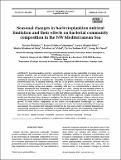Por favor, use este identificador para citar o enlazar a este item:
http://hdl.handle.net/10261/27229COMPARTIR / EXPORTAR:
 SHARE SHARE
 CORE
BASE CORE
BASE
|
|
| Visualizar otros formatos: MARC | Dublin Core | RDF | ORE | MODS | METS | DIDL | DATACITE | |

| Título: | Seasonal changes in bacterioplankton nutrient limitation and their effects on bacterial community composition in the NW Mediterranean Sea |
Autor: | Pinhassi, Jarone; Gómez-Consarnau, Laura CSIC ORCID; Alonso-Sáez, Laura; Sala, M. Montserrat CSIC ORCID ; Vidal, Montserrat; Pedrós-Alió, Carlos CSIC ORCID; Gasol, Josep M. CSIC ORCID | Palabras clave: | Marine bacteria Nutrients Bioassays Seasonal variability Diversity |
Fecha de publicación: | 10-oct-2006 | Editor: | Inter Research | Citación: | Aquatic Microbial Ecology 44(3): 241-252 (2006) | Resumen: | Bacterioplankton growth is expected to depend on the availability of organic and inorganic nutrients. Still, no studies have investigated how the magnitude and type of nutrient limitation experienced by marine bacteria change on a temporal scale. We carried out a series of nutrient enrichment experiments to examine the variability in nutrient limitation of bacteria in the NW Mediterranean Sea, at monthly intervals, over an 18 mo period. Short-term enrichment bioassays (24 h incubation) showed that bacterial P limitation could occur throughout the year, but was most pronounced during spring and summer, coinciding with very low concentrations of dissolved inorganic phosphorus and chlorophyll a, and higher N:P ratios. During the non-stratified period in autumn and winter, bacteria were at times strongly C limited. Inorganic nitrogen limitation was not detected at any time. Long-term bioassays with and without enrichment, where growth was monitored until stationary phase using the seawater dilution culture approach, largely confirmed the results from the short-term bioassays. Analysis of the bacterial assemblages in these cultures, using denaturing gradient gel electrophoresis (DGGE) and 16S rRNA gene sequencing, suggested that the growth of some central components of the native bacterioplankton assemblage (i.e. specific Roseobacter and Flavobacteria phylotypes) was restricted due to the limited availability of P in spring and summer. We conclude that seasonal variability in the type and severity of nutrient limitation can substantially contribute to the regulation of bacterioplankton growth and community composition, and thereby affect the turnover of dissolved organic matter and inorganic nutrients in the sea | Descripción: | 12 pages, 5 figures, 2 tables | Versión del editor: | https://doi.org/10.3354/ame044241 | URI: | http://hdl.handle.net/10261/27229 | DOI: | 10.3354/ame044241 | ISSN: | 0948-3055 |
| Aparece en las colecciones: | (ICM) Artículos |
Ficheros en este ítem:
| Fichero | Descripción | Tamaño | Formato | |
|---|---|---|---|---|
| Pinhassi_et_al_2006.pdf | 410,98 kB | Adobe PDF |  Visualizar/Abrir |
CORE Recommender
SCOPUSTM
Citations
140
checked on 17-abr-2024
WEB OF SCIENCETM
Citations
135
checked on 27-feb-2024
Page view(s)
400
checked on 22-abr-2024
Download(s)
202
checked on 22-abr-2024
Google ScholarTM
Check
Altmetric
Altmetric
NOTA: Los ítems de Digital.CSIC están protegidos por copyright, con todos los derechos reservados, a menos que se indique lo contrario.
